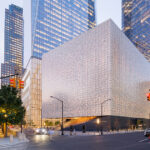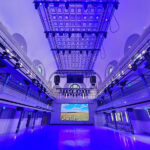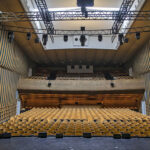Lumenpulse Sets a 19th-Century Structure Aglow using 21st-Century Technologies.
Lumenpulse, a specification-grade LED lighting solutions manufacturer, recently provided their Lumenbeam luminaires for the restoration project of the RJ Corman Railroad Bridge. Built in 1890, yet still structurally sound, the bridge, spanning the Cumberland River in downtown Clarksville, TN, was rusting and appeared dilapidated. A simple new coat of silver paint just would not do.
Brian Thomas with Tennessee Lighting Sales, the company hired by a Tennessee government coalition, turned to Lumenpulse for a solution.
Founded in 2006 in Montreal, Canada, Lumenpulse designs, develops, manufactures, and sells a wide range of high performance and sustainable specification-grade LED solutions for commercial, institutional and urban environments.

The LED Life Cycle
To appreciate the company’s impressive growth and unique product line, a little LED 101 is in order. LED’s do not “fail” in the same way as other lighting technologies. Instead of going out like a traditional light source, LEDs just get dimmer and dimmer over time.
L70 is the industry standard notation for when an LED has dimmed to 70 per cent of its original brightness, which is enough for the naked eye to perceive a noticeable difference. This was determined as the “end of the life” of the fixture. In reality, it is more likely that a driver or power supply will fail before an LED goes completely “out.”
This is due to heat complications. While LED’s do not necessarily radiate heat, the power supply and driver will generate heat in their hermetically sealed chamber, which other manufacturers generally couple on the rear of a fixture.
Unlike the uniform degradation of the LED’s, these elements will fail at varying points in their use. The inherent problem with such a design is that the entire fixture needs replaced, but not all of them at the same time, as their failure rates vary. Once the new fixtures go online, they are obviously brighter than the other original fixtures.
No amount of dimming will get these two sets of fixtures to match again, because they are degrading from two different start points.

Keeping Brightness in Sync
Lumenpulse solved this problem with several innovations. Placing their version of a driver known as the smartboard™ on the front of the fixture with the LED’s was the first step. The company then chose to use “off the shelf” standard power supplies and kept these positioned on the rear of the fixture, making them easily replaceable and accessible to the end user.
Finally, all of the products in the Lumenbeam family have fins or openings known as the two-chamber system. These create a chimney like effect which draw cool air into the LED’s and smartboard while blowing the dissipating heat from the power supply out of the fixture. The fixture is constantly cooling itself.
In addition, lumenlife™ is a technology that calculates the true life expectancy of a luminaire by taking into account environmental factors (including operation temperature and dimming usage) that influence a system’s lifetime. This technology gives lifetime feedback and can even issue alerts as the system starts to approach the end of its useful lifetime.
Another innovation is the use of glass on glass, cutting down on diffusion for better transmittance. Each LED in a Lumenbeam fixture has a glass head with whatever optics specification is ordered, be it very narrow, narrow, medium, or wide. A glass lens slides over the open face, instead of the standard polyurethane common with other manufacturers.
“We do this with all our outdoor fixtures,” says Bryan Gazo, U.S. regional sales manager for the Southeast. “It is the number one reason Lumenpulse is so successful and why our fixtures output more light than the competition.”
Gazo an industry veteran and former LD for Aerosmith, Deep Purple, Bad Company, and Cheap Trick in the 1980’s and 90’s, has been with Lumenpulse since 2011.

Choosing the Right Product
“When Brian called to tell me they wanted to brighten up the bridge and give it a unique nighttime appearance,” said Gazo, “I asked him the same first question I ask all of our clients. ‘How bright do you want it?’”
A standard part of the Lumenpulse process for a project includes a photometric study. “This confirmed our initial decision that the Lumenbeam Large Color Changing Luminaire would work best,” he said. The fixture is a high-performance, 50W luminaire for solving complex lighting challenges and applying dynamic color to multi-story building exteriors and structures.
After viewing a nighttime demonstration mockup using two of the fixtures on the bridge, a small party comprised of various members from the restoration committee agreed.
“They told us, ‘It just looks unbelievable, let’s go for it!’” smiles Gazo. In all, 108 Lumenbeam Large Color Changing 10˚ luminaires were installed at the base of the bridge’s columns to accentuate the industrial architecture of the historical bridge. During commissioning a Lumenpulse tech programmed time clocks, seasonal color changes, and time changes. A third party Pharos provides control.
The fixture also meets the 3GV standard, which is an ANSI rating for vibration. “What happens, says Gazo, “is every time a train rolls over that bridge, it is gonna rattle that light. Without 3GV, in a couple of years, you have fixtures literally shaken to pieces.”
A Team Approach
Lumenpulse founder FrancoisXavier Souvay — “FX,” as his employees call him, envisioned a company that respects the aims of lighting designers and the needs of the end-user. This philosophy was the guiding force behind how the company designs and manufactures durable, high-performance fixtures while ensuring they are simple to specify and configure. To do this, he needed to create his own R&D division within the company. He immediately began hiring the experts and engineers who would bring his vision to reality.
All manufacturing for North America takes place in Montreal, Canada, while their technology division resides in Boston. Their worldwide presence includes sales and manufacturing offices in the U.K., France, Italy, Hong Kong and Singapore. Lumenpulse is a build to order manufacturer.
The company currently has more than 103 patents granted and 54 patents pending for innovations resulting from intensive investment in this R&D strategy. One such innovation is lumentalk,™ which enables digital control of LED lighting over existing AC power lines. Simply replace existing fixtures with Lumenpulse products, and place lumentalk in line with the DMX controller. This eliminates any additional conduit, wiring, or construction.
Gazo offers up a personal observation that speaks to the ultimate reason for the success behind Lumenpulse. “I have never been with an organization that has such a team attitude. I was one of the first 50 people hired, and now there are more than 600 employees. Everybody works with the knowledge that opportunities are going to come. From the top down, we are told not to fret about a job lost; we’re not saving lives here, you know. Just go out there and keep having fun.”
And that is a bridge everyone is happy to travel.
For more information, visit www.lumenpulsegroup.com.


